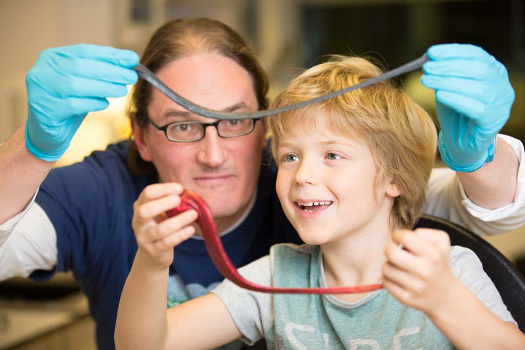 |
| February 07, 2017 | Volume 13 Issue 05 |
Designfax weekly eMagazine
Archives
Partners
Manufacturing Center
Product Spotlight
Modern Applications News
Metalworking Ideas For
Today's Job Shops
Tooling and Production
Strategies for large
metalworking plants
Graphene + Silly Putty = Super-sensitive sensor

Professor Jonathan Coleman and his son, Oisin, with the amazing 'G-putty' made from adding graphene to the Silly Putty kids play material.
Researchers working in Trinity College Dublin (TBD) in Ireland have used the wonder material graphene to make the novelty children's material Silly Putty (polysilicone) conduct electricity, creating extremely sensitive sensors. This world-first research, led by School of Physics Professor Jonathan Coleman from TBD and in collaboration with Prof Robert Young of the University of Manchester, potentially offers exciting possibilities for applications in new, inexpensive devices and diagnostics in medicine and other sectors.

The team's findings have been published in the leading journal Science.*
Coleman, who is also Investigator in AMBER (the Science Foundation Ireland-funded materials science research center), along with postdoctoral researcher Conor Boland, discovered that the electrical resistance of the putty infused with graphene ("G-putty") was extremely sensitive to the slightest deformation or impact. They mounted the G-putty onto the chest and neck of human subjects and used it to measure breathing, pulse, and even blood pressure. It showed unprecedented sensitivity as a sensor for strain and pressure, hundreds of times more sensitive than normal sensors. The G-putty also works as a very sensitive impact sensor, able to detect the footsteps of small spiders. It is believed that this material will find applications in a range of medical devices.
"This material is well known as the children's toy Silly Putty," says Coleman. "It is different from familiar materials in that it flows like a viscous liquid when deformed slowly but bounces like an elastic solid when thrown against a surface. When we added the graphene to the Silly Putty, it caused it to conduct electricity, but in a very unusual way. The electrical resistance of the G-putty was very sensitive to deformation, with the resistance increasing sharply on even the slightest strain or impact. Unusually, the resistance slowly returned close to its original value as the putty self-healed over time."
"While a common application has been to add graphene to plastics in order to improve the electrical, mechanical, thermal, or barrier properties, the resultant composites have generally performed as expected without any great surprises," says Coleman. "The behavior we found with G-putty has not been found in any other composite material. This unique discovery will open up major possibilities in sensor manufacturing worldwide."
* "Sensitive electromechanical sensors using viscoelastic graphene-polymer nanocomposites," Boland et al, Science, Dec 9, 2016.
Published February 2017
Rate this article
View our terms of use and privacy policy
